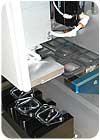
Computers,
mobile phones and handheld electronic devices all use adhesive components in
numerous instances, including labels, insulators, shields, and screens. Photo
Courtesy of Smartserv Online Inc.
The use of adhesive-backed components is steadily growing as a method for assembling much of today’s technology. Computers, mobile phones and handheld electronic devices all use adhesive components in numerous instances, including labels, insulators, shields, and screens. While this trend is improving product performance, the lack of standardized assembly platforms inhibits the adoption of adhesive technology and its broad-based acceptance.
Problem
Manufacturers currently specify equipment for individual projects. This practice, by nature, leads to varying degrees of success using adhesive components, as the lack of adhesive component assembly experience of the engineers involved often times leads to a failure at the manufacturing level. These failures cast uncertainty on the use of adhesive components as viable assembly tools in high-volume products.In many instances, custom machines are developed around the specific requirements of a particular assembly job. Although certain custom machines will perform the desired requirement successfully, the use of “one-off” and “customized” equipment handicaps the entire industry. Custom equipment is manufactured on a limited timeline and pushed into production to meet the anticipated launch date and volume requirements of the end product. Manufacturing locations are then saddled with the burden of ensuring that the equipment is kept operational and yielding required volumes regardless of its actual suitability. The end result is the machinery being scrapped, or minimal parts are salvaged for reuse. Thus, the cycle begins anew with each successive project, significantly increasing costs and eroding efficiencies. Adding to the complexity, manufacturing sites are increasingly located in low-tech regions with limited technical capabilities. Often, machinery is abandoned altogether for hand assembly, even when it does not meet application requirements.
Solution
Standardized machines have established operational criteria, predictable quality and - perhaps of greatest benefit - quantified process costs. Standardized machinery is also refined and enhanced through years of development with a process that allows for continuous improvement. Research indicates that the cost of assembling adhesive components exceeds the cost of the components themselves. By comparison, this relationship is reversed in other more mature processes. For example, the assembly of electronic components to PCBs is performed by industry-standard machinery. At times, the cost of the component packaging in standard tape and reel format exceeds the cost of the component. Still, the benefits recognized from increased assembly efficiency and reliability more than offset the higher packaging expense that enables the component to run on standard equipment. Industry insiders may have an opinion on which brand of machine is superior, but there is no question that this type of machinery and the standard delivery methodology for the components will be used to perform the assembly. Thus, when one looks at the industry as a whole, it is standardized.A closer analysis of electronic pick and place equipment provides insight into how standardization can impact and proliferate a specific technology. Most PCBs are assembled on machines that are in-house permanent capital equipment for many OEMs, ODMs and EMS providers. These machines have been refined to perform this assembly task with such great efficiency and quality that this equipment is used in even the cheapest of labor markets. The supply chain has evolved with the understanding that these machines will be used. Consequently, suppliers are empowered to focus on improvement of their core technology with the expectation of success. By adopting standardization for assembling adhesive components, manufacturers will have proven, predictable methods of using these components. This predictability and reliability will give design engineers the freedom and comfort to use the technology with the assurance of successful implementation.
End users should consider the following additional items in calculation of the benefits of standardizing adhesive component assembly.
- Technical support and maintenance are simplified.
- Decreased downtime and quickly reconfigurable equipment are distinct advantages where product lifecycles are short and time-to-market is critical.
- The reusability factor of standardized equipment exceeds 95%, while the reusability of customized solutions cannot be forecast.
- Shorter lead times of standard equipment allow critical decisions to be made later in the planning process, when more information is available.
- Equipment manufacturers can have the machinery “on the shelf” or manufacturing sites could have automation in place prior to design finalization.
- Time-proven, predictable production-rate data will provide for extremely accurate planning and forecasting.
- Prototyping runs and capability studies can be performed early in the process, prior to production exposing any problems.
- Capital costs are spread out, significantly reducing overall assembly costs.

Supply Chain Involvement
Standardization not only allows for refinement of the machinery involved, but all related supporting technologies are continuously improved. Adhesive manufacturers are left with a certain amount of guesswork when developing solutions for automated assembly. The assembly method is often undefined when the adhesive supplier is initially involved and assembly requirements must therefore be anticipated. This leads to customization for every new high-volume application. The results are an excessive amount of research for individual projects. These costs, while difficult to quantify, are quietly passed throughout the supply chain to the OEM.Alternatively, in the previously discussed mature PCB assembly model, the equipment parameters are defined and the part delivery methods are standardized. This model would allow adhesives manufacturers to focus on their core competency of manufacturing adhesives. Manufacturing the raw materials for standardized products would lead to larger batch sizes for fewer products. Thus, a reduction in costs associated with raw materials, process setup and reactor cleanup would be recognized. Increased manufacturing experience with the same polymer would yield more consistent “batch to batch” adhesive performance. Product carriers to transport the components would be better defined for automated application also allowing for their refinement.
The challenges faced are then compounded when the adhesive is sent to the converter at the next step in the value chain. Converters take the raw material from suppliers and typically “convert” the material from roll form to the actual size and shape of the specific applications requirement. The converter is faced with the daunting task of taking raw material that was manufactured without any consideration given to the method of final assembly and providing the customer with die-cut adhesive that will work on their chosen assembly method. Frequently, the liner that the adhesive is supplied on is unsuitable for automation, causing processing difficulties and increased costs. Many times, the automation choice has not been determined at the time the converter is involved, rendering them helpless to affect a positive outcome. This usually results in an iterative process of the converter manufacturing parts with different adhesives in various layouts on different liners until one is established as acceptable. Thus, given the intense product launch pressure, large amounts of resources are dedicated by both the converter and their customer to solve issues expeditiously and at any cost. This pattern is repeated time after time at manufacturing locations worldwide. Without widespread standardization no entity alone can sufficiently influence the entire supply chain enough to eradicate the inefficiency.
Conclusion
Many organizations independently recognize the benefits of standardization in their assembly processes. These organizations alone lack the influence or importance to drive standardization throughout the entire marketplace. Therefore, while they realize the portion of the benefits related to standardization on the manufacturing floor, they lack the power to capture the greater impact realized from a standardized pressure-sensitive adhesive industry.Although the merits of standardization are quite compelling, the involvement of OEMs will be required to fully realize benefits. In most cases, these organizations, which can benefit the most, are completely unaware of the burden on the industry or the associated cost impact of the lack of standardization. By working together to achieve standards, OEMs, ODMs, EMS providers, adhesive suppliers, converters, and standard machine builders can realize the impact of a technology proliferation.
For more information, contact Mike Terry, Global Sales Manager, AccuPlace, 1800 NW 69th Ave., Plantation, FL 33313, or visit www.accuplace.com.